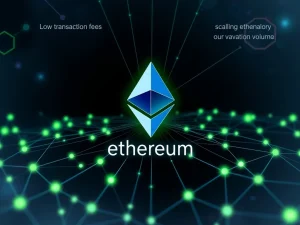RISC-V Ethereum: Unlocking the Future of Smart Contracts?

Ethereum is constantly evolving, seeking ways to handle more users and transactions efficiently. A hot topic sparking significant debate in the community is the potential integration of RISC-V Ethereum. But why is this gaining traction, and what could it mean for the future of decentralized applications and Ethereum smart contracts?
What Exactly is RISC-V?
RISC-V, pronounced “risk five,” isn’t a physical chip but rather an open-source blueprint for creating computer processors. Think of it as a standardized language processors understand. Based on reduced instruction set computing (RISC) principles, it’s designed to be simple, modular, and highly flexible.
- Open Source: Unlike proprietary designs like ARM or x86, RISC-V is free to use and modify.
- Modular: Developers can pick and choose specific instruction sets needed for a task.
- Efficient: Its simple design can lead to more efficient hardware implementations.
This flexibility makes RISC-V suitable for a wide range of applications, from tiny embedded systems to powerful data centers — and potentially, blockchain virtual machines.
Why Vitalik Buterin Proposed RISC-V for Ethereum
Ethereum co-founder Vitalik Buterin RISC-V proposal aims to tackle a core challenge: the network’s execution layer bottleneck. Despite significant upgrades like The Merge, processing smart contracts and transactions remains a key limitation on Ethereum scalability.
Buterin suggests replacing or complementing the existing Ethereum Virtual Machine (EVM) with RISC-V as the language for writing and executing smart contracts. His argument is that RISC-V could significantly boost the speed and efficiency of the execution layer, simplifying the system and resolving a major scaling constraint.
“It aims to greatly improve the efficiency of the Ethereum execution layer… replace the EVM with RISC-V as the virtual machine language that smart contracts are written in,” Buterin stated.
This proposal comes as users increasingly rely on Layer 2 solutions for cheaper, faster transactions, highlighting the ongoing need for core network improvements to maintain Ethereum’s position as a leading smart contract platform.
How Could RISC-V Work on Ethereum?
Integrating RISC-V isn’t a simple flip of a switch. It’s currently a proposal under discussion, with several potential paths outlined:
-
Dual Virtual Machines: Support both the existing EVM and a new RISC-V VM. Contracts could be written in either language, and ideally, they could interact with each other. This allows a gradual transition.
-
Complete Switch with Conversion: A more radical approach involves modifying the protocol to convert existing EVM contracts to work with a new RISC-V based system. New contracts would be written directly in RISC-V.
-
Using an Interpreter: A practical transitional solution could involve an interpreter layer. This translates EVM code to RISC-V (or vice-versa) on the fly, allowing developers to start building in RISC-V while ensuring older contracts continue to function without breaking existing DApps.
The primary technical hurdle is ensuring backward compatibility and avoiding disruption to the vast ecosystem of existing Ethereum smart contracts.
Key Benefits: RISC-V vs. EVM
Comparing EVM vs RISC-V reveals potential advantages that could justify such a significant architectural shift:
-
Improved Efficiency: Buterin suggests potential efficiency gains, theoretically up to 100x, though real-world gains would likely be less but still substantial. RISC-V’s simpler design is better suited for certain computational tasks than the EVM.
-
Optimized for ZK Proofs: RISC-V is seen as inherently better suited for Zero-Knowledge (ZK) proof systems. ZK rollups are crucial for Ethereum’s future scalability and privacy roadmap. Using RISC-V could simplify the development and improve the performance of ZK-optimized execution layers by reducing overhead associated with EVM’s administrative tasks like gas accounting.
-
Lower Gas Fees: Increased processing efficiency at the execution layer could translate directly to lower computational costs and, therefore, lower gas fees for users.
-
Enhanced Scalability: By improving the execution layer’s capacity and efficiency, RISC-V could help the network handle more transactions, directly addressing Ethereum scalability concerns.
It’s important to note that the vision isn’t necessarily about completely replacing the EVM for *all* tasks, but rather leveraging RISC-V where it offers significant advantages, particularly as a backend for ZK rollups where proving costs are dominant.
The Debate: Challenges and Community Reaction
While the potential benefits of RISC-V Ethereum are significant, the proposal has sparked considerable debate within the community. Implementing such a fundamental change is technically complex and raises valid concerns:
-
Execution Performance: Some developers worry that while ZK proving might improve, the overall execution performance of smart contracts could slow down due to the abstraction layer or the fundamental differences between the EVM’s U256-based design and RISC-V.
-
Technical Difficulty & Cost: Rearchitecting a core part of the Ethereum protocol is a massive undertaking requiring significant development effort and resources, potentially taking years.
-
Priority: Given the technical debt and other roadmap items, some question if this ambitious change is the most urgent priority for the network right now.
As with any decentralized project, the final decision rests not just on technical feasibility but also on community consensus. Buterin’s proposal has opened a vital conversation about the future direction and potential architecture of Ethereum’s execution layer.
Conclusion
The proposal to integrate RISC-V Ethereum is a bold vision aimed at fundamentally improving the efficiency and Ethereum scalability, particularly for Ethereum smart contracts and ZK-proof systems. While Vitalik Buterin RISC-V idea holds promise for significant performance gains and potential cost reductions for users, it also presents complex technical challenges and requires careful consideration and broad community support. The debate around EVM vs RISC-V highlights the ongoing efforts to refine and strengthen Ethereum’s core architecture for the future.









